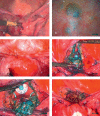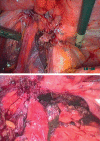The diagnosis and treatment of deep infiltrating endometriosis
- PMID: 20644707
- PMCID: PMC2905889
- DOI: 10.3238/arztebl.2010.0446
The diagnosis and treatment of deep infiltrating endometriosis
Abstract
Background: Endometriosis and adenomyosis uteri are the most common benign disorders affecting girls and women after uterine myomas (fibroids), with a prevalence of roughly 5% to 15%. There have been many advances in diagnostic assessment and in our understanding of the disease over the past decade. Steady improvements in treatment have been accompanied by heightened consciousness of the diagnosis among the affected women and the doctors who care for them.
Methods: A selective literature search was carried out in the Cochrane and PubMed databases using the key words "endometriosis," "deep infiltrating endometriosis," "endometriosis AND diagnostics," "endometriosis AND surgical therapy," "endometriosis AND endocrine treatment," and others. The AWMF and ESHRE guidelines were also taken in account.
Results and conclusion: The main manifestations are primary or secondary dysmenorrhea, bleeding disturbances, infertility, dysuria, pain on defecation (dyschezia), cycle-dependent or (later) cycle-independent pelvic pain, nonspecific cycle-associated gastrointestinal or urogenital symptoms. Cycle-associated problems of urination and/or defecation that are due to endometriosis are most common in young, premenopausal women. Whenever such manifestations are present, endometriosis should be considered in the differential diagnosis, and evidence for it should be sought in the clinical history, physical examination, and ultrasound findings. If endometriosis is histologically confirmed and is of the deeply infiltrating kind, the recommended management today is to refer the patient to an endometriosis center.
Figures






References
-
- Meyer R. Stoeckel W, editor. Die Pathologie der Bindegewebe, Geschwülste und der Mischgeschwülste. Handbuch der Gynäkologie. München. J.F. Bergmann. 1930:211–853.
-
- Leyendecker G, Herbertz M, Kunz G, Mall G. Endometriosis results from the dislocation of basal endometrium. Hum Reprod. 2002;17:2725–2736. - PubMed
-
- Mechsner S, Bartley J, Loddenkemper C, Salomon DS, Starzinski-Powitz A, Ebert AD. Oxytocin receptor expression in smooth muscle cells of peritoneal endometriotic lesions and ovarian endometriotic cysts. Fertil Steril. 2005;83(Suppl 1):1220–1231. - PubMed
-
- Bulun SE. Endometriosis. N Engl J Med. 2009;360:268–279. - PubMed
-
- Mechsner S, Schwarz J, Thode J, Loddenkemper C, Salomon DS, Ebert AD. Growth-associated protein 43-positive sensory nerve fibers accompanied by immature vessels are located in or near peritoneal endometriotic lesions. Fertil Steril. 2007;88:581–587. - PubMed
MeSH terms
LinkOut - more resources
Full Text Sources
Other Literature Sources
Medical
Miscellaneous

